Vegetables: October is prime planting for many cool-season vegetables. Plant Broccoli, Brussels sprouts, Cabbage, and Cauliflower from transplants. Swiss chard, Kale, Kohlrabi, Leeks, Spinach, Collards, Lettuce, Mustard Greens, Asian Greens and Spinach may be planted from seed or transplants. Beets, carrots radishes, and cool-season peas such as snap, English and snow peas should be planted directly from seed. Be sure to follow directions on thinning carrots, beets, radishes, lettuce and spinach in order to produce a harvestable crop!
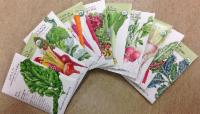
October is the best month to plant Garlic from cloves separated from “seed bulbs”, as well. Click HERE for our Garlic planting guide.
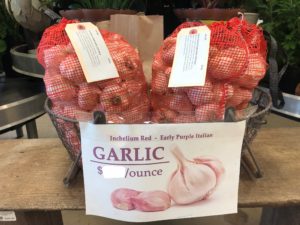
Be sure to have your Bt or Spinosad on hand to preventatively treat for Cabbage loopers and other caterpillars that can devour your crops. Aphids can be discouraged by washing with a spray of water, or using Insecticidal Soap. Transplants of Artichokes can be planted this month for spring harvest. They will need protection from a hard freeze, so be sure to have some “frost fabric” on hand for those really cold nights.
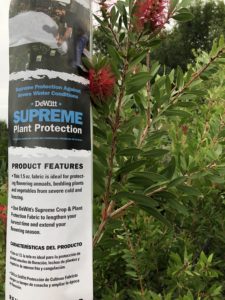
Row covers can be constructed now to be ready for the placement of “frost fabric” on lettuce and other tender crops when temperatures fall.
Check for proper seeding depth when planting from seed, and keep seed bed moist as seeds germinate. Fertilize cool-season vegetables every week or two with Happy Frog Tomato and Vegetable Fertilizer, and continue to water regularly.
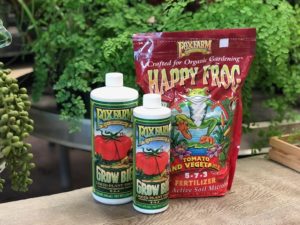
Plant strawberries now for a spring harvest. Protect from hard freezes and be sure to fertilize so they will grow and produce runners for spring fruit-bearing.
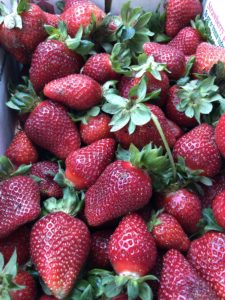
October is also the best month to plant winter-hardy herbs in your garden. Rosemary, Thyme, Oregano, Sage, Winter Savory, Lavender, Chives, Salad Burnet, Chamomile and Rue may all be planted now to produce plants ready for harvest in the spring.
Lawns: Fall often brings conditions that are conducive to disease development, such as rain and cool temperatures. If you have had Brown Patch fungus in an area of your lawn in the past, treat the area preventatively BEFORE the symptoms occur if cool, wet weather is in the forecast. Change irrigation on the lawn to morning hours so the leaves will dry quickly, as wet leaves provide a place for fungal spores to germinate. If your lawn has been diagnosed with Take-all Patch, spread ½” of peat moss per 1000 square feet, using the back of a soil rake to get it into contact with the level of the runners. Follow the application with a light irrigation. The acidic nature of the peat moss will inhibit germination of fungal spores and prevent spread of the fungus over the winter. If your lawn has heavy thatch, rent a de-thatcher and remove the thatch to prevent spread of the fungus in the thatch layer during the winter months.
Fertilize this month with MicroLife organic fertilizer with beneficial microorganisms and mycorrhizal fungi. Research has shown that these organisms assist in the uptake of water and nutrients and are even known to assist in disease suppression.
Prevent winter weeds by applying a pre-emergent herbicide such as Hi Yield Turf and Ornamental Grass Stopper with Dimension or organic Corn Gluten to PREVENT seeds from germinating. Be sure to water-in with ½” of water to activate.
Avoid overseeding of lawns with ryegrass, as it can stress our warm season grasses during the transition in the early spring. Bermuda and Zoysia can tolerate overseeding, but St. Augustine cannot.
Annuals and Perennials: Warm-season annuals are looking tired from a hot summer, and cool-season annuals are ready to take their place. Choose from pansies, snapdragons, ornamental cabbage and kale, dianthus, alyssum, lobelia, violas, and cyclamen for planting in pots or in beds.
Seed bluebonnets, poppies, and larkspur now for a spring show. Plants will germinate now, remain about the same size through the winter, then “pop up” and bloom when spring arrives.
Plant evergreen perennials throughout the fall. Salvia greggii, Pink Skullcap, Blackfoot Daisy, Rosemary, Jerusalem Sage, Damianita, Lavender, and Four Nerve Daisy.
Divide spring-blooming plants such as canna, daylily, coneflower and Bearded Iris now. As a general rule of thumb, divide flowering plants in the season OPPOSITE their bloom season.
Trees and Shrubs: Fall is the prime planting season for winter-hardy ornamentals such as roses, trees and shrubs. Winter gives the roots time to establish before the heat of next summer sets in. Be sure to plant at the same depth as the original root ball, as planting too deeply can cause the plant to “fail to thrive” or even die.
Amend the backfill soil with no more than 1/3 compost to 2/3 native soil. Using a potting soil or pure compost is not recommended, as the roots will not leave the planting hole if the soil is too good! Hand-watering, as opposed to relying on rain or overhead irrigation is recommended.
Continue to water any trees or shrubs planted in the spring or summer throughout the winter. Roots are still establishing and will do better if a regular watering schedule is followed. An evergreen tree or shrub will require more frequent watering than a deciduous tree or shrub, and attention should be paid to windy days, as wind removes moisture from the leaves. Water an evergreen well if a “wind advisory” is issued, especially if newly established.
Read about establishing deciduous and evergreen trees in the winter HERE.
